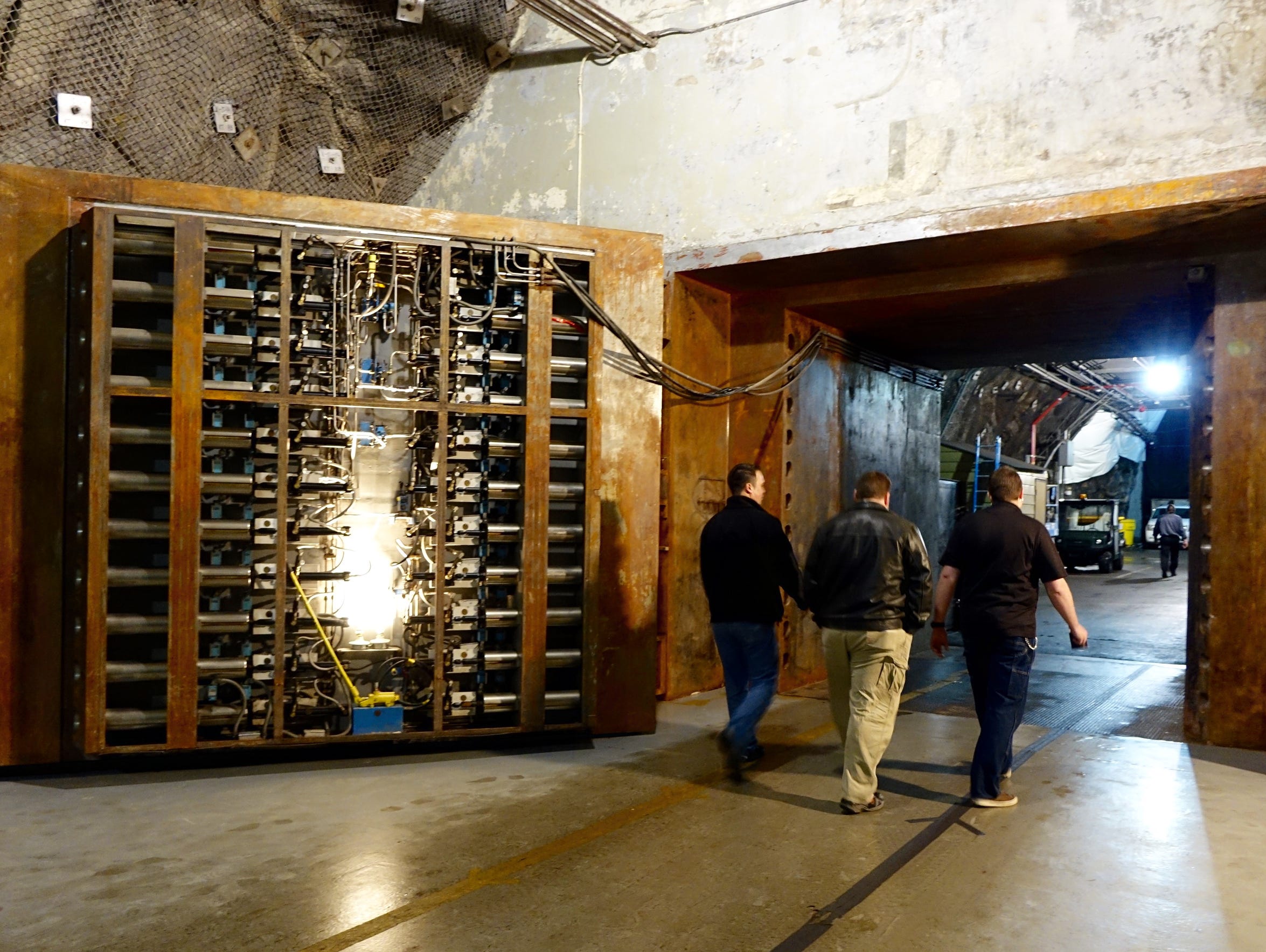NORAD's Hidden Bunker Keeps The (Data) Snoops Out

CHEYENNE MOUNTAIN AIR FORCE STATION, Colo. The white rowboat bobbing on an underground lake deep inside this hollow mountain isn't the most unique feature of America's most secure intelligence and data center.
Well, it might be. But we'll probably never know.
That's because Cheyenne Mountain holds the kinds of secrets America won't share with anyone lacking a top secret security clearance. The linked caves a mile inside are home to some of the world's most sophisticated satellite and other tracking systems.
The caves are locked behind 23-ton blast doors, just some of the catastrophe-ready features that have captured the imagination of sci-fi buffs who sometimes climb over the perimeter fences looking for a fictional Stargate or hidden aliens. Trespassers typically get arrested before they even get near the bunker's front doors, reached by driving a mile through a tunnel carved out of solid rock.

More than a mile inside a Colorado mountain, a complex of steel buildings sit in caves protecting them from nuclear attack. The bunker is home to a variety of top secret military analysts. Trevor Hughes/USA TODAY
The bunker was originally built to help military commanders survive a direct Soviet nuclear attack, and Cheyenne Mountain in central Colorado still plays a key role in American air and space supremacy because it's virtually impervious to attacks on the electronics housed there. The mountain's shielding means the military can remain in contact with satellites above even if workers are completely sealed inside.
In other words, this is a facility of last resort, designed to keep running no matter what is happening outside.
To understand the bunker's present and future, it's helpful to start in the past.
"It's a tribute to the fear and American and Canadian will that during the Cold War, they were literally willing to hollow out a mountain, move a mountain," said U.S. Navy Capt. Jeff Davis, a spokesman for NORAD.
NORAD, or the North American Aerospace Defense command, was created as a joint American-Canadian effort to monitor the skies for ballistic missiles and other attacks from above. Its founders knew their headquarters would be among the first targeted during nuclear war. If they took out NORAD, the fear went, the Soviets could blind Americans to a second wave of attacks.
That grim expectation is easier to understand after walking into the echoing caverns blasted out in the 1960s. Two thousand feet below the surface, buildings made of battleship steel sit on springs isolating them from earthquakes that could accompany a nuclear blast outside. The mountain itself is about 9,500 feet tall, and the tunnel entrance sits about 2,000 feet from the top.

The buildings inside the Cheyenne Mountain bunker sit on springs to cushion them from a nuclear blast. The springs are randomly inspected annually, and all utilities entering the buildings are designed with slack in the cables to allow the buildings to sway up to 18 inches.
(Photo: Trevor Hughes, USA TODAY)
Underground reservoirs carved from solid rock provide drinking and cooling water, while a lake of diesel fuel sits ready for the six locomotive-sized diesel generators capable of powering a small city. A spring uncovered during construction provides fresh water, and a bank of batteries provides even more backup power while ensuring the facility hasn't had so much as a power flicker in 14 years.
That protection and redundancy help the bunker carry out its largely classified mission to help keep America safe, especially from space and air threats. NORAD and the U.S. Air Force monitor the skies over North America for ballistic missiles, space debris and hostile aircraft. Though NORAD commissioned the bunker, it moved the bulk of its operations to nearby Peterson Air Force Base in 2006.
NORAD maintains a small continuous presence inside the underground complex and routinely practices operating from there. In a crisis, its leaders would retreat to the bunker for safety and security.
The remaining 70% of the complex is used by the U.S. Air Force for a variety of classified missions. These days, the blast doors remain open the majority of the time. They were shut during 9/11 and are closed and opened daily to ensure they still work. The bunker remains a hedged bet against a nuclear attack, ensuring critical command and surveillance systems keep running during a worst-case scenario.
After a series of news articles this year wrongly said NORAD was moving back into the mountain, officials with the Air Force's 721st Mission Support Group granted a USA TODAY journalist an unusually extensive behind-the-scenes tour of the facility. Photography was tightly restricted, and most buildings inside the complex remained off-limits because they're open only to people with top secret military clearances.
But the tour, given by the facility's deputy director, Steven Rose, offered a glimpse into a world most Americans will never see.

Workers enter the Cheyenne Mountain bunker through the inner blast door, which is normally painted white but has been stripped to bare metal to remove lead paint during renovation. When closed, the hydraulic pins on the door's sides extend into the mountain, locking it closed. The yellow handle allows people to close the door manually if the hydraulics fail.
(Photo: Trevor Hughes, USA TODAY)
Cheyenne Mountain sits just south of Colorado Springs, the state's second-largest city. Peterson Air Force Base sprawls about 20 miles away, while Fort Carson, an Army post, is just across the street. Getting to the bunker's famous tunnel entrance requires passing through two security checkpoints.
The access tunnel actually goes completely through the mountain, so if a nuclear bomb exploded outside, the blast waves would funnel past the bunker entrance, which sits at a 90-degree angle from the tunnel. Those 23-ton doors are shaped like plugs, meaning any blast would tighten their seals during an attack. Hydraulics can close the doors in about 20 seconds, while the military guards stationed in the tunnel outside can close them by hand in about 40 seconds.
Deep inside the mountain, the main entrance to the steel buildings is a prosaic office door leading to a warren of corridors, most of which are off-limits to those without proper clearance. Workers inside include military men and women from both the USA and Canada, along with contractors who support the military mission and the bunker's operations.
About 350 people work inside the bunker daily, Rose says, and about 170 stay there overnight. NORAD can move its full operations into the bunker during an emergency but normally runs from nearby Peterson, Davis said.
"There was just a recognition that we had gotten too big for the mountain," Davis explained.
Though the mountain still holds many secrets, one of its best features has taken on new importance. Thanks in large part to the granite under which it's buried, Cheyenne Mountain is impervious to electromagnetic radiation. An electromagnetic pulse invariably accompanies a nuclear explosion, and an EMP can fry nearby electronics, from phones and laptops to cameras, radios, GPS units and even vehicles.

Rain falls in front of the iconic entrance to the Cheyenne Mountain bunker beneath a Colorado mountain. The tunnel travels a mile through solid rock before reaching the blast doors behind which the bunker sits. Heavy security measures restrict photography of the site.
(Photo: Trevor Hughes, USA TODAY)
Today, data from antennas, telescopes, satellites and other surveillance systems flows into the bunker for analysis and aggregation before being passed to decisionmakers elsewhere. The specific work remains largely classified. The bunker is the country's single-best EMP-protected complex, Rose said, and serves as the ultimate backup during a nuclear attack.
"As we become increasingly reliant on electronic systems, that aspect of it has become much more central to our thinking," Davis said.
The bunker's security measures have helped give it a larger-than-life presence in Hollywood, thanks to the Terminator , War Games and Independence Day movies, along with last fall's Interstellar , and the long-running sci-fi show Stargate SG-1 .
Once inside the buildings, it's hard to see the protections that make it a bunker of last resort. That's by design. There's a convenience store and cafeteria, along with a gym, chapel and spin class room. Most spaces pull double duty: The spin room can quickly be converted into a medical triage bay, while the private contractor who operates the cafeteria can quickly be replaced by military cooks.
Still, the carpet and lighting make portions of the facility look much like any other cubicle farm, even if the only "window" views come from televisions showing a live feed of the outside parking lots.
"We try to eliminate the feeling that you're working in a cave," Rose said.

A fiberglass boat floats on a football-field-sized lake hewn from solid rock beneath Cheyenne Mountain. The lake actually tilts down, so only a small portion of the surface is exposed, which reduces the danger water will splash out during an earthquake caused by a nuclear explosion outside.
(Photo: Trevor Hughes, USA TODAY)
But a cave it is. Recent rain meant the noise of dripping water was ever-present inside the caverns as moisture migrated through the rock. The water reservoirs used as a backup facility cooling system are hewn out of solid rock, their reservoirs tilted down into the Earth to reduce the risk they'll spill out during a bomb-caused earthquake.
A small rowboat bobs on the surface of one of the reservoirs, a boat that Rose jokes gives him the status as the deputy head of the largest underground Navy in America. Workers use the boat to inspect the reservoirs, but it also serves a more solemn purpose: Some of the U.S. Navy personnel stationed at the bunker climb aboard to renew their enlistment as part of a long-standing tradition to renew at sea.
The reservoirs allow the bunker to operate with its doors closed for "several weeks," Rose said. The '70s-era diesel generators have enough fuel to keep the entire facility powered for that time, and there's stocks of supplies in seemingly endless locked cabinets lining the buildings' walls.
To Rose and Davis, the bunker represents the ultimate in American Cold War ingenuity but it's still ready to meet the needs and challenges of the modern world.
"Like anything, the military has changed in 50 years, and so have we," Rose said. "It's the overlapping of history and future."
http://www.usatoday.com/longform/news/2015/06/12/norad-cheyenne-mountain-bunker/28689013/


Cheyenne Mountain is familiar to many for different reasons - for some it is as the strategic linchpin of the U.S. nuclear missile program andto others it is part of their memories of Matthew Broderick and the movie War Games.
I was stationed at Ft Carson in the 80's and know some folks who have stationed at Cheyenne Mountain an their description of duty there was a single word "intense".
Perhaps the last really totally secure place left in the current electronic miasma that we call the world today